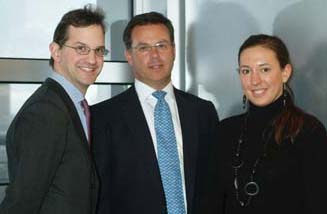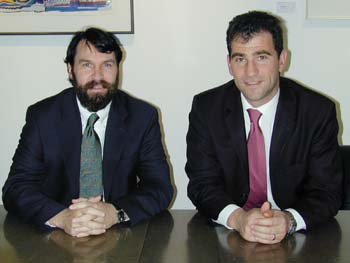For the first International Finance Facility for Immunisation debt issue to succeed, lead managers Goldman Sachs and Deutsche Bank had to devise a way of frontloading development finance at an affordable cost. Edward Russell-Walling reports on a scheme designed to ensure reliable funding for vaccine projects.
The capital markets are not celebrated for their tender, loving kindness. Perhaps that is why the players like to do the right thing if they get the chance – provided it makes economic sense, of course. That would explain why the world’s first triple-A charity bond was such a success with investors.
With apparent ease, last November’s inaugural debt issue from the International Finance Facility for Immunisation (IFFIm) raised $1bn in five-year money at 5%. The project did a lot more than simply uncover an institutional caring streak, however, and it was only the execution phase that seemed easy.
IFFIm is the first new supranational borrower since the European Bank for Reconstruction and Development arrived on the scene in 1991. It was created from scratch to raise funds against the security of government pledges and then pass them on to an international child vaccination programme. The bonds are a way of frontloading development aid from grant promises that may be staggered over 20 years.
The paper is triple-A rated by the three big rating agencies, not least because of legally binding commitments from sovereign donors that have waived their immunity to being sued for the money. Crucially for the donors, the deal structure means they can account for multi-year grants over the life of the commitment, instead of having to put it all on their books in year one.
Gordon Brown’s brainchild
If any single person can take the credit for IFFIm, it has to be UK chancellor Gordon Brown. He floated the basic idea in a speech to the Federal Reserve Bank in New York in November 2001, only weeks after the World Trade Center bombing. His message was that, if 9/11 was not to be repeated, increased development aid was vital, and he proposed the creation of a new international development trust fund to invest in the poorest countries.
At the time, development assistance ran to $53bn a year, $30bn of it to the poorest countries. In a report for the United Nations, former Mexican president Ernesto Zedillo had estimated that another $50bn a year was needed up to 2015 if the Millennium Development Goals (MDGs) were to be met. Mr Brown insisted that this was achievable.
“One of a number of ways is for national governments to pre-commit development resources – for, say, 30 years or more,” he said. “And with national governments offering a guarantee, either through callable capital or other means as security, it is possible to lever up these contributions to reach our targets.”
Workable structure
In the summer of 2002, the UK Treasury asked a group of banks to see if they could turn the idea into a workable structure, paying particular attention to the need to account for governmental grants over the life of their commitment. One of the banks, Goldman Sachs, suggested injecting an element of conditionality into the cashflows. If they were conditional in some way – if the fund did not know at the outset exactly how much it would receive – they could be accounted for as they were paid, and not up-front. However, for the markets to lend money against the cashflows, that conditionality would have to be measurable.
The Treasury agreed that such a so-called high-level financing condition could indeed fit the bill. But what form should it take? “We proposed that, if a recipient country went into long-term arrears – more than six months – with the International Monetary Fund [IMF], then part of the donor cashflows to that country would be turned off,” says Christopher Egerton-Warburton, head of the sovereign, supranational and agencies group at Goldman Sachs, which became the project’s financial adviser.
Goldman Sachs (from left to right): Christopher Egerton-Warburton, James Garvey and Maud Casin
The wagons began slowly to roll. In 2003, the Treasury circulated a working paper on the subject and an advocacy process was started, to persuade other potential donors and institutions that this was an appropriate scheme. Finance ministers at that year’s World Bank/IMF meeting asked the two institutions to evaluate various development funding options, including the Treasury’s proposal.
The first pilot
“It’s very hard to evaluate this kind of idea in its conceptual form,” Mr Egerton-Warburton points out. “We realised it would be very valuable if a pilot could be created. At the same time, by happy coincidence, GAVI [Global Alliance for Vaccines and Immunisation] was approaching the UK and other governments in search of a significant increase to its funding.”
GAVI was launched in 2000 to improve access to immunisation for children in poor countries. Its partners include governments, Unicef, the World Health Organisation, the World Bank, vaccine manufacturers, health organisations and, not least, the Bill & Melinda Gates Foundation. After a successful first five years, it was looking for a “dramatic” hike in financial support, and was chosen to be the first recipient of IFFIm funding.
“Reducing child mortality is one of the MDGs, and immunisation is a very effective near-term development investment,” notes Doris Herrera-Pol, head of capital markets at the World Bank. “If the funding had been for more controversial work, the task could have been much harder.”
Donor commitments
To succeed, the structure still needed the blessing of the statistical authorities – in this case, Eurostat and the UK’s Office for National Statistics. Their green light for the vital accounting treatment finally came through in the summer of 2005. At that point, five donor governments committed themselves to the project: the UK, France, Italy, Spain and Sweden. They were joined later by Norway.
It was time for the team to make it happen. IFFIm had been set up as an English charity, with a five-member board chaired by Ulster Bank chairman Alan Gillespie. One of IFFIm’s attractions is that it is a virtual institution, without the establishment and overheads of other multilaterals. Instead, its entire treasury function was outsourced – after a suitable selection process – to the World Bank, as treasury manager.
Affordable frontloading
Early in 2006, the World Bank and Goldman Sachs presented the board with their proposals for IFFIm to issue its first bond. “The challenge was to create a mechanism that would frontload development finance at a cost comparable to where existing multilateral institutions funded themselves,” says Mr Egerton-Warburton. “Frontloading at any cost would not have been a victory.”
By now – although the project had not begun with this in mind – the team had set its sights on supranational status. “It was critical that donors’ commitments to IFFIm were legally binding government obligations,” says Ms Herrera-Pol. Contact was made with rating agencies, regulators, the European Commission, the Bank for International Settlements and others. Between them, they needed to agree to IFFIm’s status as a multilateral development bank, with its accompanying 0% risk weighting.
As all the pieces started to come together, Deutsche Bank was appointed joint lead manager for the transaction, alongside Goldman Sachs, and a tri-continental roadshow swung into action.
Deutsche Bank: Bill Northfield (left) and Ralph Berlowitz
“The transparency of the funding objectives and the social responsibility aspect of the deal struck a chord among the leading investors in Europe and the US,” says Bill Northfield, co-head of Deutsche Bank’s frequent borrower group. “The cashflows made this a multilateral development institution, so it was priced like a supranational.”
US interest
Market feedback had favoured a minimum transaction size of $1bn with a term sweet-spot of five years, and price guidance of agencies plus 0-2 basis points (bp). Traditional supranational investors flocked to buy, given their shortage of supply. Less predictable was a strong block of demand from the US, particularly the west coast, where social mandates abound. Retail demand was also stronger than normal, perhaps helped by a publicity machine that had persuaded Pope Benedict XVI, Bono and Bob Geldof to buy the bonds.
Finally priced at five-year US Treasuries +31bp, the issue was a handsome 1.75 times oversubscribed. It has performed particularly well in the secondary market, tightening to +21bp at one stage and leaving a number of other agency names in its wake – including Cades, the French government agency.
IFFIm will return to the capital markets to raise a net total of $4bn over the next 10 years. “It’s not necessary to do a benchmark issue every year,” notes Ms Herrera-Pol. “IFFIm will be more like other supranationals, issuing bonds every two years or so. But we are reviewing the possibilities for retail investors, who have expressed a lot of interest.”
So, a retail issue soon? “It’s not impossible,” says Ms Herrera-Pol, “depending on the disbursement needs of GAVI.” And as this particular pilot may be presumed a success, expect the IFFIm model to be flattered by imitation as soon as multilateral agreement can be secured.




